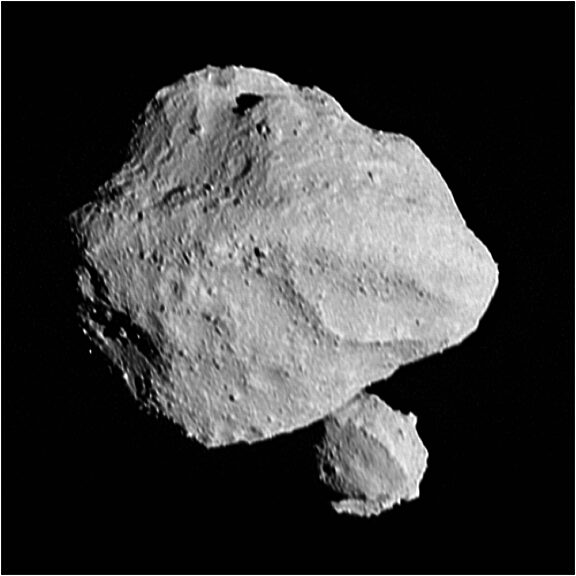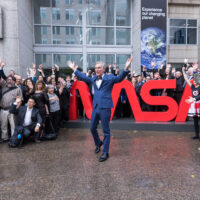Lucy, exploring Jupiter's Trojan asteroids
Highlights
- NASA's Lucy mission will be the first to explore a group of asteroids, called Trojans, that share Jupiter's orbit around the Sun.
- Lucy visited the main belt asteroids Dinkinesh in 2023 and Donaldjohanson in 2025. Between 2027 and 2033, it will visit eight Trojan asteroids.
- Trojan asteroids are leftover planet-building materials from the formation of the Solar System. Studying these small worlds tells us more about our origin story.
Why send a mission to Jupiter’s Trojan asteroids?
Small worlds can help answer big questions. Where did we come from? How did we get here? How rare are planets like ours? Asteroids, especially Trojan asteroids, provide a window into these mysteries. Most of them are leftover from the beginning of the Solar System.
When the planets initially formed 4.6 billion years ago, some smaller pieces of rock, ice, and metal remained around the Sun. Many of these remnants broke up or combined over time. Others eventually impacted planets, and may have even helped deliver water and organic compounds — the building blocks of life as we know it — to Earth. But some of these small worlds stayed in orbit around the Sun. Unlike our planet, whose distant past has been largely erased by processes like weather and geologic activity, these asteroids remain largely intact and preserve a record of the early Solar System.
NASA's Lucy mission is on its way to explore a group of asteroids, called Jupiter’s Trojans, that are thought to be made up of many such time capsules. These asteroids drift in two large groups: one ahead of Jupiter in its orbit around the Sun, and one behind it. Sharing an orbit with the gas giant in this way is very stable. Most Trojan asteroids likely drifted inward from the outer Solar System soon after the formation of the planets and have been caught in their orbits ever since.

Lucy will be the first spacecraft ever to visit the Trojan asteroids. Launched in 2021, it has already visited three asteroids in the main asteroid belt. Next, between 2027 and 2033, it will visit eight Trojan asteroids. The Lucy mission is named after the fossilized hominin skeleton that helped scientists learn where humans fit into the evolutionary tree of life. Just like its ancestral namesake, Lucy aims to give us a more complete picture of our origin story.
What will NASA’s Lucy mission do?
Jupiter’s Trojan asteroids are divided into two groups that flank the giant planet as it orbits the Sun. To visit both groups, Lucy must reach an elongated orbit around the Sun that roughly carries it between Earth and Jupiter.
After launching in 2021, Lucy flew past Earth in 2022 for a gravity assist. In 2023, it performed a flyby of the main belt asteroid Dinkinesh, revealing a small moon. The moon turned out to be a contact binary, made of two objects touching one another. In 2025, it flew past asteroid Donaldjohanson, named after one of the co-discoverers of the Lucy fossil.

Lucy’s first trip out to Jupiter will carry it through the leading swarm of Trojan asteroids collectively known as the Greek camp. The spacecraft will fly past Eurybates and its moon Queta in August 2027, Polymele and its moon in September 2027, Leucus in April 2028, and Orus in November 2028.
Then, Lucy will fall back towards Earth before returning to Jupiter's orbit. On its second visit, Lucy will fly through the trailing swarm of Trojan asteroids (confusingly, the trailing group is called the Trojan camp). On this trip, Lucy will visit Patroclus and companion asteroid Menoetius in March 2033.
This will complete Lucy’s primary mission. However, the spacecraft will remain in a stable orbit between Earth and Jupiter, providing opportunities for an extended mission and more asteroid visits.

What is the Lucy spacecraft like?
Lucy takes up about as much space as a large swimming pool, but most of that is its large solar panels. If you took away the solar arrays, the main body of the spacecraft — where all the scientific instruments are — would only be about the size of a garden shed.
These instruments include L’Ralph, an imager and spectrometer that will map Lucy’s target asteroids and their chemical makeup of rocks and ices, L’LORRI, a camera for more detailed imaging, and L’TES, a spectrometer to characterize asteroids' thermal properties. The odd names for these instruments come from their being based on similar instruments used by past missions: L’Ralph is based on the Ralph instrument that is flying on the New Horizons spacecraft, L’LORRI is based on the LOng Range Reconnaissance Imager (LORRI) of that same mission, and L’TES is similar to the Thermal Emission Spectrometer (TES) on the OSIRIS-REx and Mars Global Surveyor spacecraft.

Who is leading the Lucy mission?
Lucy is being led by Harold F. Levison, who is the principal investigator for the mission and an institute scientist at the Southwest Research Institute (SwRI) in Boulder, Colorado. NASA’s Goddard Space Flight Center (GSFC) manages the mission under the direction of NASA’s Planetary Missions Program Office. NASA GSFC built one of the instruments aboard, and most of the Lucy team is affiliated with either SwRI or NASA. The mission is funded by NASA.
The Lucy spacecraft itself was built by The Lockheed Martin Corporation, and other instruments were contributed by the Johns Hopkins University Applied Physics Laboratory and Arizona State University.
How much does Lucy cost?
The Lucy spacecraft will cost approximately $989 million over 16 years. But that's not the whole story.
Support missions like Lucy
Whether it's advocating, teaching, inspiring, or learning, you can do something for space, right now. Let's get to work.


 Explore Worlds
Explore Worlds Find Life
Find Life Defend Earth
Defend Earth



